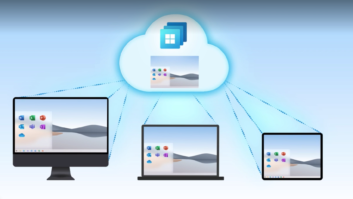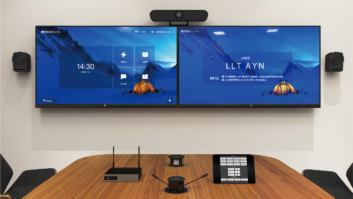In the first of a new series of columns about the impact of IT on the world of AV, high-tech industry analyst Bob Snyder examines the implications of cloud computing
Cloud computing is blowing in, shaking IT windows and rattling AV halls.
In English, to have one’s head in the clouds is to be out of touch with reality; a cloud on the horizon is a threat coming your way – sooner rather than later; and if you are under a cloud, people have a poor or unfavourable opinion of you.
None of that stopped the IT industry from defining the next big thing in computing as ‘cloud computing’. Just as the iPad, tablets and netbooks are destroying and redefining the PC market one more time, cloud computing will smash, destroy and break all the IT business models in the market – and even some of ours in AV.
The whole nature of computing is going topsy-turvy and, as with many related industries, the IT sector will take AV along for the roller-coaster ride.
Definition debates
First, AV integrators need to understand that IT can’t even agree on a definition for what’s happening. Cloud computing is a messy business. Here’s a suggestion: next time you hear a company offering a service ‘in the cloud’, simply change the phrase to ‘over the internet’. That will do as a starter.
Think about how Google is better placed to remotely (over the internet) provide millions of people with email service (Gmail) than those millions could provide on their own with resources on their own premises. Take a look at Salesforce.com and see how they have grown to a giant by supplying their service ‘in the cloud’ (internet-based instead of on your desktop).
@page_break@
Secondly, when you hear the term ‘cloud’, be aware that just as in nature, clouds in the IT troposphere come in different varieties (private clouds, public clouds, hybrids and more) and they can differ by what they service (platforms, applications, or infrastructure and data storage).
Any way you define it, cloud computing is already redefining the landscape. Gartner Research says a true cloud needs to have five attributes: it must be based on a service model; scalable to a multitude of users; shared with others; include pay-by-how-much-you-use billing; and be delivered over IP.
So how does all this cloudy weather affect AV? You don’t need a weatherman to know which way the wind is blowing. This is a big, big change in the way companies and organisations will think about their needs for anything that attaches to an IP network. The shift in AV to digital technologies means we have to come to grips with cloud computing just to understand that the environment around us is changing in a dramatic way. Cloud is not a fad, a trend, a blip on the screen… this is a paradigm shift from which there is no return.
All about the internet
The internet is the enabler that will shift focus from hardware to service. At the extreme, imagine if control makers stopped selling on-premise systems to control AV, and instead chose to sell a minimum of ‘dumb’ hardware with the intelligent control piped down from the internet. Like the way your electricity works: you turn it on and only pay for it when it is on.
Installers would have less kit to sell, less installation to bill. They will be asked to sell on commission and they will bill the customer for the service by the month. This sounds scary but that is exactly what is happening in IT today and, yes, channel partners are rocked by it.
OK, we won’t fall off the cliff and tomorrow find ourselves in the AV clouds. But many of the signal management, content distribution, digital signage players and video security box-makers will gradually stop putting their software, their technology inside boxes and will instead move it ‘in the cloud’.
@page_break@
Demanding customers
The driving force behind cloud is capex reduction where companies and institutions can reduce their budgets because they can rent digital technology, rather than own it. Once organisations learn that this trick saves them money, they will demand the same from AV.
Organisations, large and small, with huge libraries of digital storage to access and maintain – video surveillance or classroom lectures, for example – will want their archives ‘in the cloud’.
AV-as-a-Service
Cloud-based AV is definitely here in the digital signage market. Take a look at Broadsign’s Digital Signage as a Service. Content is 100% digital in every digital signage application where content is sent (or streamed) over IP networks to a Windows- or Linux-based media player that just plays on demand, and it can be controlled remotely via IP.
We could use that same concept in many AV applications (such as classrooms and meeting rooms) when we venture beyond the digital signage application.
Another example: in selling and integrating digital signage systems, we install the media players, the CMS software and the displays, but the big money’s in the content. NEC’s cloud-based VUKUNET lets any commercial AV integrator stream ads to their installed digital signs and then share the advertising revenue. You don’t have to sell the ads – you just have to make sure there’s an internet connection to the digital signage players you integrate.
@page_break@
Going mobile
Cloud computing is growing because it also solves the mobility needs. As computing goes mobile, clouds enable that mobility. Video anytime, anyplace, is the mantra. More than 130 million enterprise customers will use mobile cloud-based services by 2014, says Juniper Research. This trend to mobile cloud will pull in AV. Think of corporates delivering video to a remote sales force (and customers) and universities with lectures on smartphones.
There will be new winners and losers. AV manufacturers will change the way they do business; AV distributors will have to adapt, and AV integrators will adjust accordingly. Like usual in business, no one has a reserved space at the top of the ladder.
Every cloud has a silver lining – that’s another way of saying that clouds may seem ominous but they can bring opportunity as well.
Next feature in the series: The dawn of the Zettabyte Era







